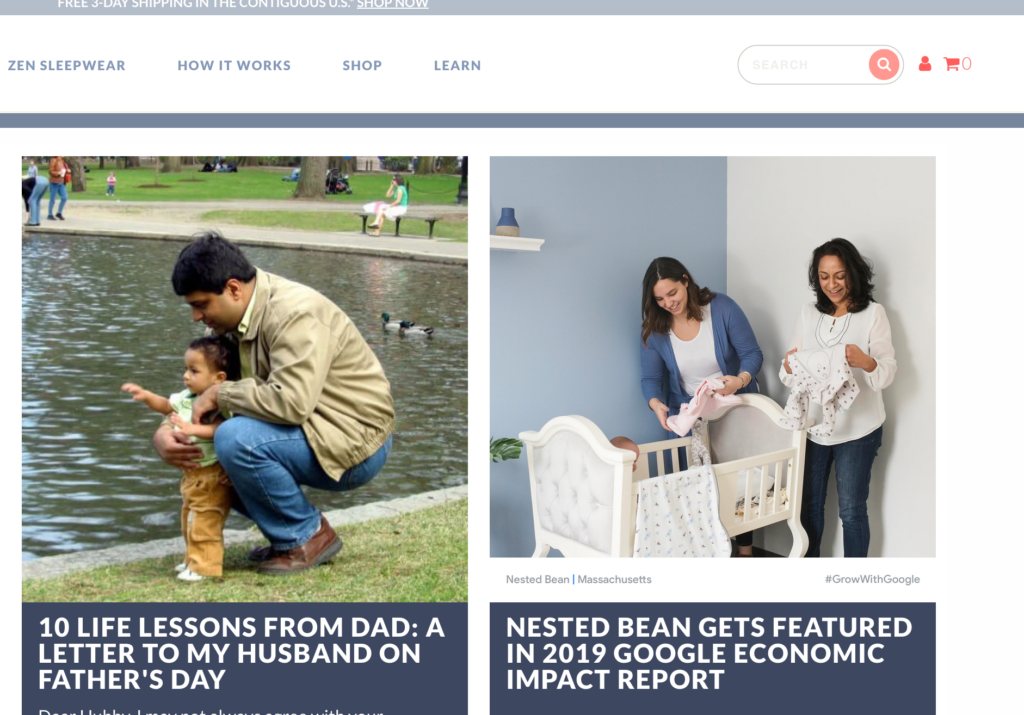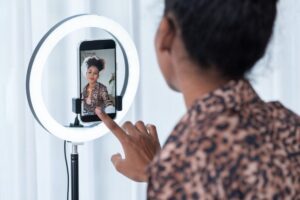 Our monthly profile of an outstanding marketer whose leadership and campaigns are moving the needle for their brand.
Our monthly profile of an outstanding marketer whose leadership and campaigns are moving the needle for their brand.
—
When he wasn’t being held in his mother’s arms, Manasi Gangan’s second son refused to sleep. “Every time we would put him down he would wake up. He slept in our arms, but it was really difficult for us to sleep—for me, mainly—because I was the primary caregiver,” she says. So, she asked herself: What was it about being held that kept him asleep? Why would he wake up from his slumber as soon as that changed?
Perhaps because of her engineering background, Gangan was determined to find a solution. “Intuitively, I placed a beanie baby on his chest. That seemed to work.” And thus, the idea for a weighted swaddling blanket was born.
With 15 years’ experience building IT products for major corporations under her belt, Gangan founded Nested Bean in 2012, a company with the mission to help babies and toddlers up to two years old sleep better with the help of a weighted garments, blankets and onesies. Following is the brand’s unique marketing story and evolution—from retail to ecommerce to brand marketing and beyond.
Early Days
At the start of the brand’s marketing journey, a time when social media wasn’t quite the marketing channel that it is today, Gangan took Nested Bean’s patented design exclusively to retail giants with the goal of earning consumer trust. At that time, the brand did 95 percent of its business through retailers. “My initial thoughts were: It’s a new product. It’s a patented, differentiated design. Let’s go that route because at least it would be a chance to earn the consumer’s trust. People like to go to a certain retailer because they trust the products that are on their shelves,” she says. However, she soon realized that her products required more consumer education than they were getting from retailers.
“When we had handed the product to bloggers, our influencers at the time, they all swore by it. Their babies would not sleep without being held and were sleeping a lot more peacefully for more extended periods of time, which matched what we had tested. But we were leaving the retailers to tell our story. Our products were so differentiated that they required a consumer’s education,” Gangan says. Nested Bean’s products were not selling at the rate they’d hoped for, and the result didn’t match the feedback the brand was receiving directly from consumers. The message of the brand story: effectively shelved.
A Direct-to-Consumer Model
Come 2015, a decision was made to marketing directly to the consumer. The brand began with content marketing—specifically a video—and started using Facebook ads to tell the brand’s story, effectively removing the middleman from the equation. But that meant a sacrifice had to be made: retail efforts would have to be abandoned. “In order to focus on doing something really well, you have to choose to do something not well,” Gangan claims. Setting monthly retail targets went out of the window; funds spent on trade shows for exposure were directed towards digital marketing instead.
The next step was communicating the brand story online, which required understanding—and mapping—the customer journey. “It’s not just putting up some pretty pictures on your website. You have to really understand the customer’s online journey, which starts with awareness, then goes towards consideration, then research and then conversion. We were literally building those paths on our website,” Gangan says.

In addition to the website, the brand relied heavily on social media platforms. The brand’s target audience lived on Facebook, so it used the social platform to engage with consumers and build the brand story. And then, they caught a break from Google. Because of Nested Bean’s success with Google advertising, the tech giant gave them a call and offered up a videographer free of charge—as long as the brand committed to spending money on YouTube towards video marketing. The brand still runs that initial video on its channels today and has since developed a fruitful professional relationship with the videographer. Score.
Shift to Integrated Marketing
Nested Bean’s marketing model today is more diversified compared to the brand’s early years of direct-to-consumer marketing. “We are still performance-marketing driven, but we’ve reached a point where we use different marketing channels and platforms to facilitate the conversion,” she says. “So, we may create awareness using one platform, but the conversion might happen as a result of another platform. We have a more integrated marketing model than what we had initially started with.”
Back in 2016, the goal was customer acquisition. The brand used Facebook to introduce their products and convert, which resulted in strong ROI. “Because it’s such a need-based product, we found out very quickly that our message was resonating more with moms of a certain age bracket who had experienced the problem.” But the message of preventing sleeplessness did not resonate as well with expectant parents as did the immediate promise to alleviate sleep deprivation for both babies and the parents who care for them.
Fast forward a few years and by then the brand noticed a change in customer behavior. First touch would often occur on Facebook, but after a few days consumers would return to the brand’s website. “At that time, we did not want competitor websites, such as other retailers, to scoop up the last sale,” Gangan says. The solution: start competing at the bottom of the sales funnel through Google AdWords. “We wanted our site to be the first link when someone would make a branded search, either for our products or for our company name,” she says. The strategy ultimately led to higher sales on Amazon, Target and Buy Buy Baby retail sites, Gangan asserts.
The brand has also increased social media engagement on Instagram with influencer programs. “The first touch is happening on those channels,” Gangan says. “Then the conversion might happen as a result of the web search. We need to have presence in multiple places.” Instagram is particularly useful today for marketing and making connections with consumers. Through market research and focus groups, the brand learned that consumers perceive Instagram to be raw and truthful, whereas Facebook is seen as more polished and therefore less trustworthy. In light of this, Nested Bean uses Instagram for a softer, more personal touch and Facebook for broader brand awareness.
The brand also uses Facebook to foster a community of brand evangelists. It created an invitation-only Facebook group, the criteria being that members must have purchased one of the brand’s products. Parents discuss challenges they’ve been having with sleeplessness, receive feedback from members, celebrate baby milestones and more. The group is moderated by a Nested Bean “consumer champion” who helps nurture the community and ensures that content is not judgmental toward other members. Gangan says members treat the group like a family and feel safe to communicate freely with like-minded individuals. “It’s really wonderful to see that happen. The fact that we are in a position to do that makes me feel like I did this for a good reason,” she says.
From Sleep Products to Sleep Wellness
As Nested Bean continues to expand and grow—it reported $14 million in sales last year and has experienced 3X percent year-over-year growth since 2016—it has shifted to a brand marketing approach that includes a commitment to sleep and wellness within its community. It partners with sleep experts, co-authoring blogs with them on its website, and uses email marketing for nurturing and retention. “We are seeing that there is more and more of this need—and we are trying to fulfill that need through sleep education, not just educating on our products,” Gangan says. “We’re making a shift from being a sleep product company to a sleep wellness company.”
From a platform perspective, it’s leaning into YouTube as a way to communicate to the community using sleep experts and tips and tricks provided by real moms who’ve been through similar challenges. The result is new content marketing and education surrounding the brand that relates to its commitment to sleeping wellness. “We started with small circles of performance marketing and now we have concentric circles drawn around it that allow us to go wider and wider into our ecosystem,” Gangan says.
That expansion has unlocked many doors for the brand as it ventures into the wellness category. And it’s emphasized how the goal is to care for customers’ needs—not just to sell units. “We are recognizing that it’s not just handing her a product. It’s taking care of her sleep education, her need to be a part of a community. Because at the end of the day, that’s what they want. When everything else goes out the window and the baby’s still not sleeping, all she needs is just an empathetic ear.”






